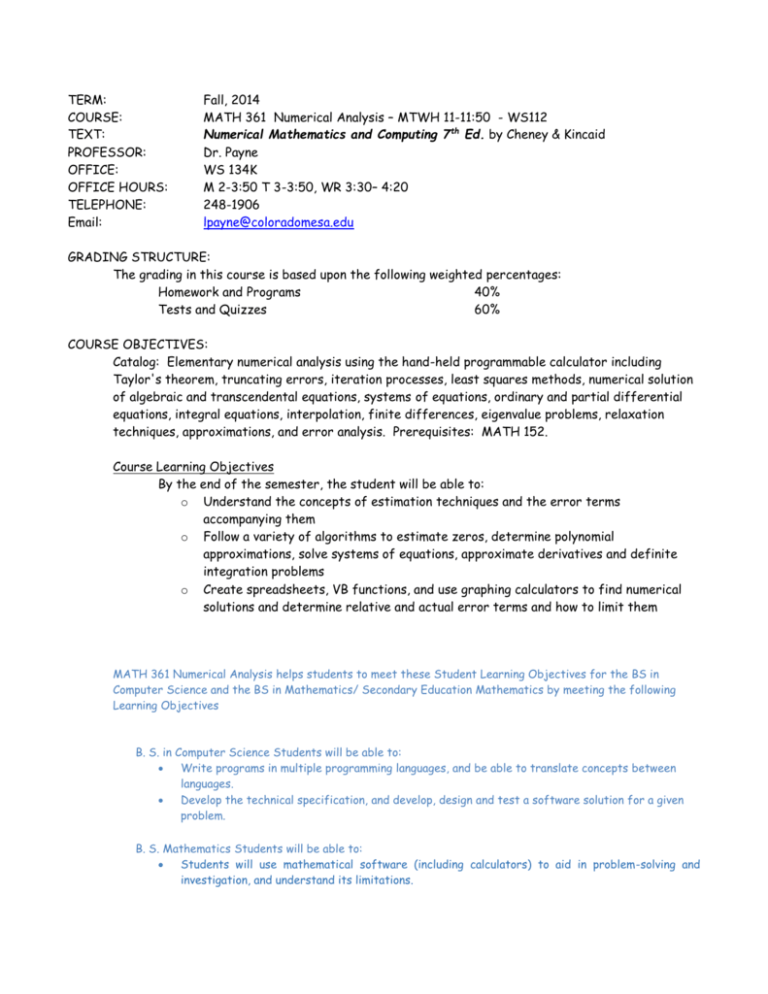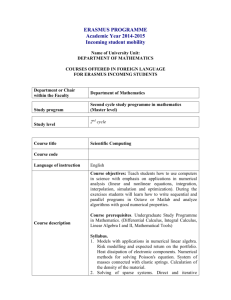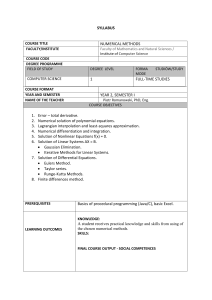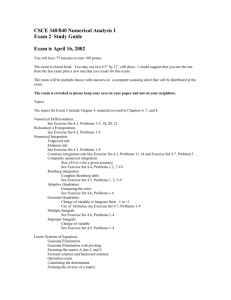TERM - Colorado Mesa University
advertisement

TERM: COURSE: TEXT: PROFESSOR: OFFICE: OFFICE HOURS: TELEPHONE: Email: Fall, 2014 MATH 361 Numerical Analysis – MTWH 11-11:50 - WS112 Numerical Mathematics and Computing 7th Ed. by Cheney & Kincaid Dr. Payne WS 134K M 2-3:50 T 3-3:50, WR 3:30– 4:20 248-1906 lpayne@coloradomesa.edu GRADING STRUCTURE: The grading in this course is based upon the following weighted percentages: Homework and Programs 40% Tests and Quizzes 60% COURSE OBJECTIVES: Catalog: Elementary numerical analysis using the hand-held programmable calculator including Taylor's theorem, truncating errors, iteration processes, least squares methods, numerical solution of algebraic and transcendental equations, systems of equations, ordinary and partial differential equations, integral equations, interpolation, finite differences, eigenvalue problems, relaxation techniques, approximations, and error analysis. Prerequisites: MATH 152. Course Learning Objectives By the end of the semester, the student will be able to: o Understand the concepts of estimation techniques and the error terms accompanying them o Follow a variety of algorithms to estimate zeros, determine polynomial approximations, solve systems of equations, approximate derivatives and definite integration problems o Create spreadsheets, VB functions, and use graphing calculators to find numerical solutions and determine relative and actual error terms and how to limit them MATH 361 Numerical Analysis helps students to meet these Student Learning Objectives for the BS in Computer Science and the BS in Mathematics/ Secondary Education Mathematics by meeting the following Learning Objectives B. S. in Computer Science Students will be able to: Write programs in multiple programming languages, and be able to translate concepts between languages. Develop the technical specification, and develop, design and test a software solution for a given problem. B. S. Mathematics Students will be able to: Students will use mathematical software (including calculators) to aid in problem-solving and investigation, and understand its limitations. SPECIAL NOTES: No makeup tests or quizzes will be given in this class. It is the student’s responsibility to attend class every day, and to be on time. It is also the student’s responsibility to do the assigned homework and programs and the corresponding reading associated with that work. When homework is assigned, it should be turned in on time, at the start of class. Please be courteous to your classmates. Be on time for class. Be ready for that day's material. Do not play on the computer during lecture. “In coordination with Educational Access Services, reasonable accommodations will be provided for qualified students with disabilities. Students must register with the EAS office to receive assistance. Please meet with the instructor the first week of class for information and/or contact Dana VandeBurgt, the Coordinator of Educational Access Services, directly by phone at 248-1801, or in person in Houston Hall, Suite 108.” Statement of Student Engagement: An undergraduate student should expect to spend on this course a minimum of two hours outside of the classroom for every hour in the classroom. The outside hours may vary depending on the number of credit hours or type of course. More details are available from the faculty member or the department office and in CMU’s Curriculum Policies and Procedures Manual. Numerical Analysis Fall, 2014 Tentative Schedule of Topics Dates Chapter Aug 18 - 27 1 Aug 28 – Sep 8 3 Sep 11 Sep 15 – 25 Sep 25 – Oct 8 Topics Introduction to Numerical Computing, Errors Root Finding Test 1 4.3 5 Oct 9 Derivatives Integration Techniques Test 2 Oct 13 – Oct 22 2.4,4 Interpolation And Root Finding Oct 23 – Nov 5 6 Curve fitting and Splines Nov 6 Nov 5 - 13 Nov 17 – Dec 2 Test 3 6 7 Numerical Solutions to Ordinary Differential Equations Solving Systems of Equations Nov 28 Test 4 Dec 10 Final Exam ( 10 – 11:50 a.m.)




